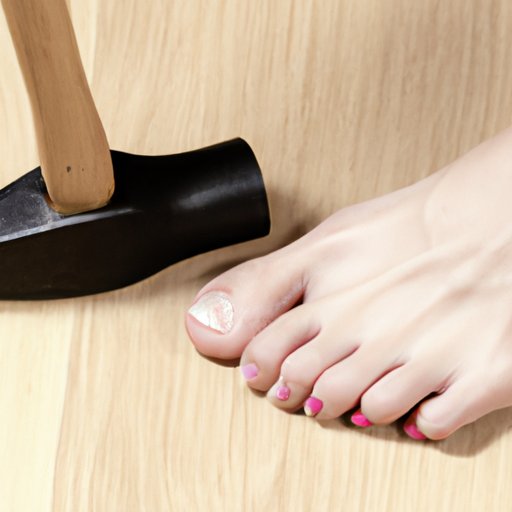I. Introduction
Hammer toe is a condition that affects the toes, causing them to bend abnormally, making it difficult to walk or wear shoes comfortably. The abnormal bending results from a muscle imbalance around the toe joint. Hammer toe can be caused by a variety of factors, including genetics, wearing tight shoes, and arthritis.
It is important to address hammer toe early to prevent it from worsening and causing long-term complications. Hammer toe can be fixed by taking a few simple steps that will be outlined in this article. These steps include exercises and stretches, orthotics, proper foot care, lifestyle changes, surgical options, and prevention.
II. Focus on Exercises and Stretches
Exercises and stretches can help strengthen the muscles in the toes and reduce the risk of hammer toe getting worse. Toe scrunches and toe curls are two exercises that can be done easily at home to strengthen the muscles in your toes.
To do toe scrunches, place a small towel on the floor and use your toes to scrunch the towel up towards you. Then release and repeat 10 times on each foot.
To do toe curls, place your feet flat on the ground and grip the floor with your toes. Hold for a few seconds before releasing and repeat 10 times on each foot.
Other exercises that can help fix hammer toe include toe extensions and toe separators.
It is important to start slowly with these exercises and work up to doing more repetitions. To help incorporate them into a daily routine, try doing them while watching TV or sitting at a desk.
III. Discuss the Use of Orthotics
Orthotics are devices that can help support the feet, reduce pain and prevent hammer toe from worsening. There are many different types of orthotics available, including shoes with arch support and cushioned soles, toe pads and splints.
Shoes with proper arch support and cushioned soles can help reduce the pressure on the toes and prevent the development of hammer toe. Toe pads can also be used to cushion the toes and reduce friction, while splints can help keep the toes in a normal position.
When choosing orthotics, it is important to look for options that are comfortable and fit properly. Custom orthotics made by a podiatrist may be necessary for those with severe hammer toe.
IV. Emphasize Proper Foot Care
Proper foot care is essential for those with hammer toe. Regularly soaking the feet in warm water and Epsom salt can help reduce pain and inflammation. Wearing proper-fitting shoes that do not squeeze the toes and keeping the toes clean and dry can also help prevent complications.
Products such as toe separators and foot creams can also be helpful for proper foot care. Toe separators can be used to realign the toes and prevent pressure on the affected area. Foot creams can help keep the skin soft and moisturized, reducing the risk of developing calluses and corns.
V. Suggest Lifestyle Changes
Lifestyle changes can also help fix hammer toe. Avoiding high heels and reducing activities that put a strain on the toes can help prevent the condition from worsening. Attending regular foot checkups can also help catch any complications early on.
It is important to make gradual changes to avoid causing additional pain and discomfort.
VI. Highlight Surgical Options
In some cases, surgery may be necessary to fix hammer toe. Osteotomies, fusions, and joint implants are all common surgical options. These surgeries involve realigning the toe joint to its normal position and can be done on an outpatient basis.
The recovery process varies depending on the surgery and the individual. It is important to follow the doctor’s instructions closely and attend any follow-up appointments.
VII. Offer Tips on Preventing Hammer Toe
Preventing hammer toe is easier than fixing it. Simple steps such as wearing shoes that fit properly, maintaining proper foot care, and stretching regularly can help prevent the condition from developing.
It is important to listen to your body and address any pain or discomfort early on to prevent further complications.
VIII. Conclusion
Fixing hammer toe can be done by taking simple steps such as exercises and stretches, using orthotics, practicing proper foot care, making lifestyle changes, considering surgical options, and preventing the condition from developing. These steps can be done at home and can help reduce pain and discomfort.
Be sure to take action early to prevent further complications. If you have any concerns, speak with a podiatrist or healthcare professional for further information or treatment.
